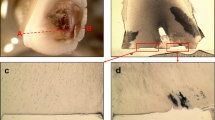Abstract
. The interaction of picosecond laser radiation with human dental tissue was investigated in this study, in order to determine the ablation rates and the surface characteristics of the dentine by using scanning electron microscopy (SEM). Dentine ablation was performed by using tooth sections of different thicknesses (0.5–2.0 mm). Dental tissue samples were irradiated in air with the fundamental wavelength and first harmonic of a regenerative amplifier Nd:YAG laser system, at 1064 nm and 532 nm, respectively, with a pulse duration of 100 ps and a pulse repetition rate of 10 Hz. The results showed very clean craters surrounded by minimum melting of the surface of dentine when the 1064 nm pulses were used. In contrast, when the first harmonic 532 nm pulses were used, the SEM examinations revealed cracks and melting of dentine with irregular surface modification. Consequently, it seems that cleaning and shaping of the root canal walls during endodontic therapy with the picosecond Nd:YAG laser application may be possible in the future. The, as yet unexplored, field of the picosecond laser interaction with hard dental tissue is expected to be a potential alternative for powerful laser processing of biomedical structures.
Similar content being viewed by others
Author information
Authors and Affiliations
Additional information
Paper received 24 February 1998; accepted following revision 20 November 1998.
Rights and permissions
About this article
Cite this article
Serafetinides, A., Khabbaz, M., Makropoulou, M. et al. Picosecond Laser Ablation of Dentine in Endodontics. Lasers Med Sci 14, 168–174 (1999). https://doi.org/10.1007/s101030050080
Issue Date:
DOI: https://doi.org/10.1007/s101030050080




